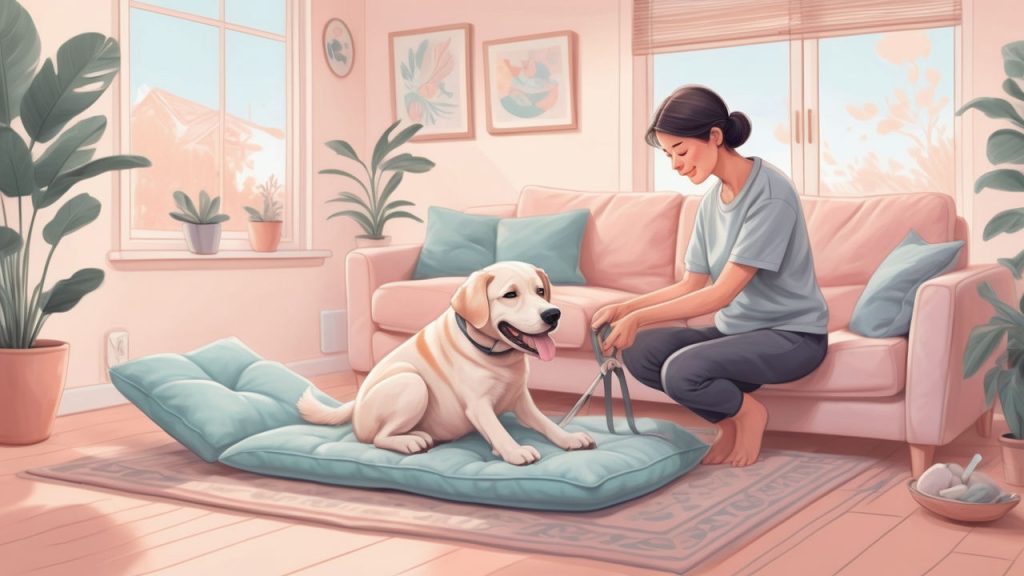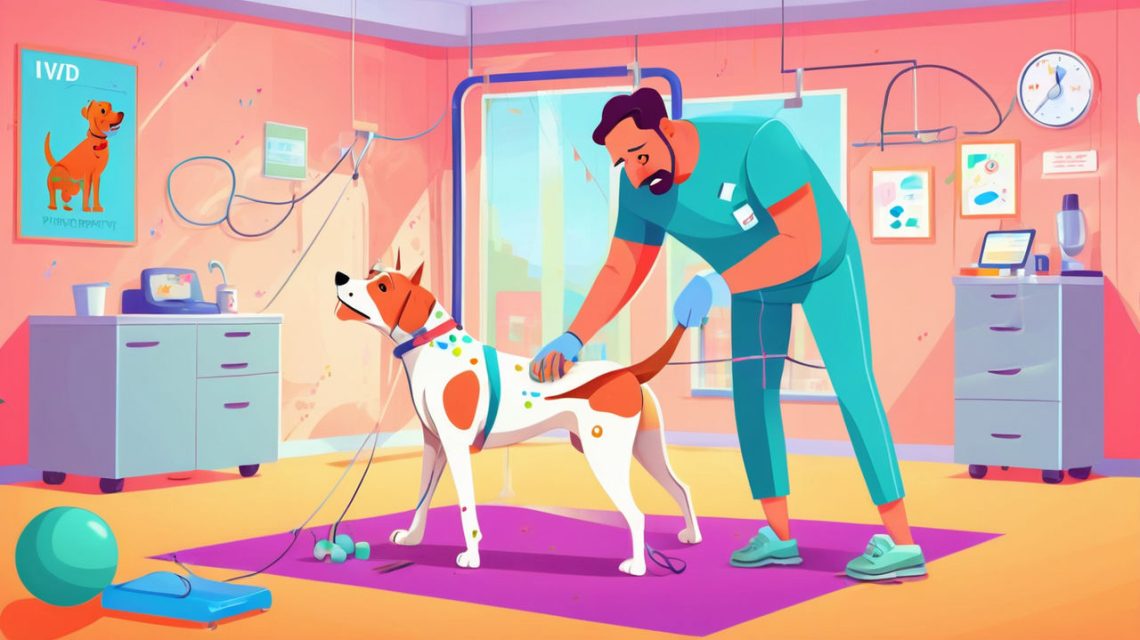Caring for a Dog with IVDD: Essential Tips for Comfort and Recovery
Intervertebral Disc Disease (IVDD) can be a heartbreaking diagnosis for any dog owner. This condition, which affects the spine, can cause pain, mobility issues, and in severe cases, paralysis. However, with the right care, many dogs with IVDD can still lead fulfilling, happy lives. Understanding the condition and how to support your dog through treatment and recovery is key to improving their quality of life.
In this guide, we’ll explore what IVDD is, the signs to look out for, treatment options, and how to care for your dog both during and after treatment. By learning how to manage your dog’s condition, you can provide them with the comfort and support they need to thrive.
What Is IVDD? Understanding the Condition
Intervertebral Disc Disease (IVDD) occurs when the cushioning discs between the vertebrae in a dog’s spine deteriorate or herniate, putting pressure on the spinal cord. This can cause pain, nerve damage, and in severe cases, loss of mobility or paralysis. IVDD is most common in breeds with long backs and short legs, such as Dachshunds, Beagles, and French Bulldogs, though it can affect any breed.
Types of IVDD
There are two types of IVDD, and understanding the difference is important for treatment:
- Type I IVDD: Common in younger dogs, this type occurs when the disc ruptures suddenly, causing acute pain and potentially severe symptoms. It often requires emergency treatment.
- Type II IVDD: This type progresses more slowly and occurs in older dogs. The discs gradually deteriorate, leading to chronic pain and weakness.
Recognizing the Symptoms of IVDD
Early detection of IVDD is crucial for effective treatment. The symptoms can vary depending on the severity of the condition and where along the spine the disc is affected. Common signs include:
- Pain or discomfort: Yelping when touched, reluctance to move, or an arched back are early signs of pain.
- Limping or weakness: Affected dogs may drag their hind legs or appear unsteady on their feet.
- Paralysis: In severe cases, dogs may lose the ability to move their legs altogether, particularly the hind legs.
- Loss of bladder or bowel control: If the spinal cord is severely compressed, a dog may lose control of their bladder or bowels.
If you notice any of these symptoms, it’s essential to seek veterinary care immediately. Quick intervention can significantly improve your dog’s chances of recovery.
Treatment Options for IVDD
The treatment for IVDD depends on the severity of the condition. In mild cases, conservative management may be effective, while more severe cases may require surgery.
1. Conservative Treatment
Conservative treatment is often recommended for dogs with mild IVDD symptoms or those who are not candidates for surgery. This approach focuses on managing pain and inflammation while allowing the spine time to heal.
- Strict crate rest: Limiting your dog’s movement is critical to avoid further injury. Crate rest usually lasts between 4 to 6 weeks.
- Medications: Your vet may prescribe anti-inflammatory medications, pain relievers, or muscle relaxants to manage your dog’s discomfort and reduce swelling.
- Physical therapy: After the initial rest period, gentle physical therapy can help restore mobility and strengthen muscles.
2. Surgical Treatment
For dogs with more severe IVDD, particularly those experiencing paralysis, surgery may be the best option. The goal of surgery is to relieve pressure on the spinal cord by removing the damaged disc material. The success rate for surgery is generally high, especially when performed soon after the onset of symptoms.
- Post-surgery care: After surgery, your dog will need several weeks of rest and rehabilitation. This may include physical therapy or hydrotherapy to help regain strength and mobility.

Caring for a Dog with IVDD: At-Home Care Tips
Whether your dog undergoes surgery or is treated conservatively, caring for a dog with IVDD requires dedication and patience. At-home care is essential to their recovery and long-term quality of life.
1. Managing Mobility
After a diagnosis of IVDD, mobility becomes a major concern. Whether your dog is recovering from surgery or undergoing conservative treatment, limiting their movement is crucial to prevent further injury.
- Crate rest: Keep your dog in a small, confined space where they can rest comfortably but cannot move around too much. Ensure the crate is padded and large enough for them to lie down and turn around, but not so large that they can walk around.
- Support harnesses: For dogs with limited mobility, a support harness can help you assist them when going outside for bathroom breaks. These harnesses support the rear or front of the dog, reducing the strain on their back.
2. Pain Management and Medications
Managing your dog’s pain is one of the most important aspects of IVDD care. Your vet will prescribe medications to help reduce pain and inflammation. Be sure to follow the medication schedule carefully and never stop medications without consulting your vet.
- Medications: Common medications include nonsteroidal anti-inflammatory drugs (NSAIDs), pain relievers, and muscle relaxants. Your vet may also recommend joint supplements like glucosamine to promote spine health.
3. Physical Therapy and Exercise
Once your dog’s condition has stabilized, physical therapy can help improve their strength and mobility. Always consult your vet before starting any exercise program.
- Passive range-of-motion exercises: These exercises gently move your dog’s legs through a range of motion to keep joints flexible and muscles strong.
- Hydrotherapy: Water therapy can be particularly beneficial for dogs with IVDD, as it allows them to exercise without putting weight on their spine.
Adapting Your Home for a Dog with IVDD
To make life easier for your dog, consider making some changes to your home. Simple modifications can prevent further injury and help your dog move more comfortably.
1. Use Ramps and Steps
Jumping onto furniture or climbing stairs can put strain on a dog’s spine, especially one recovering from IVDD. Installing ramps or pet steps will help them access furniture or beds without risking further injury.
- Tip: Encourage your dog to use the ramp with treats and praise to make it a positive experience.
2. Create a Safe, Comfortable Resting Area
Make sure your dog’s resting area is cozy and supportive. A memory foam bed can help cushion their joints and reduce pressure on their spine. Place the bed in a quiet area where they won’t be disturbed, especially during crate rest.
3. Prevent Slipping
Slippery floors can make it difficult for a dog with IVDD to walk. Consider adding non-slip mats or carpets to areas where your dog typically walks to provide better traction.
Monitoring Your Dog’s Progress
Recovery from IVDD can be slow, but with careful monitoring, you can help your dog make steady progress. Keep a close eye on their mobility, pain levels, and any changes in behavior.
1. Regular Vet Checkups
Frequent checkups with your veterinarian are essential to ensure your dog is healing properly. Your vet will assess your dog’s progress and adjust their treatment plan as needed.
2. Watch for Relapses
Unfortunately, dogs with IVDD are at risk of future disc problems. If you notice any signs of pain, weakness, or difficulty walking, contact your vet immediately. Early intervention can prevent the condition from worsening.
FAQs About Caring for a Dog with IVDD
Can dogs with IVDD recover without surgery?
- Yes, many dogs with mild to moderate IVDD can recover with conservative treatment, which includes crate rest, medications, and physical therapy. However, severe cases may require surgery for the best outcome.
How long does recovery take after IVDD surgery?
- Recovery times vary, but most dogs require at least 4 to 6 weeks of strict rest after surgery, followed by rehabilitation and physical therapy to regain strength.
How can I prevent future IVDD episodes?
- To reduce the risk of future episodes, keep your dog at a healthy weight, avoid high-impact activities like jumping, and provide ramps or steps to prevent strain on their back.
Can IVDD lead to permanent paralysis?
- In severe cases, IVDD can cause permanent nerve damage, leading to paralysis. However, with prompt treatment, many dogs regain mobility and lead happy, fulfilling lives.
Is physical therapy necessary for dogs with IVDD?
- Physical therapy can greatly benefit dogs with IVDD by improving mobility, strengthening muscles, and aiding in recovery. Always consult your vet before starting any therapy program.


